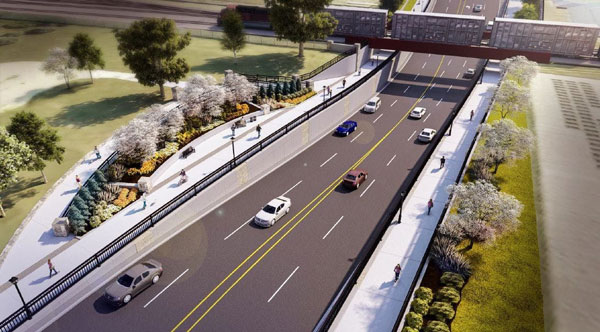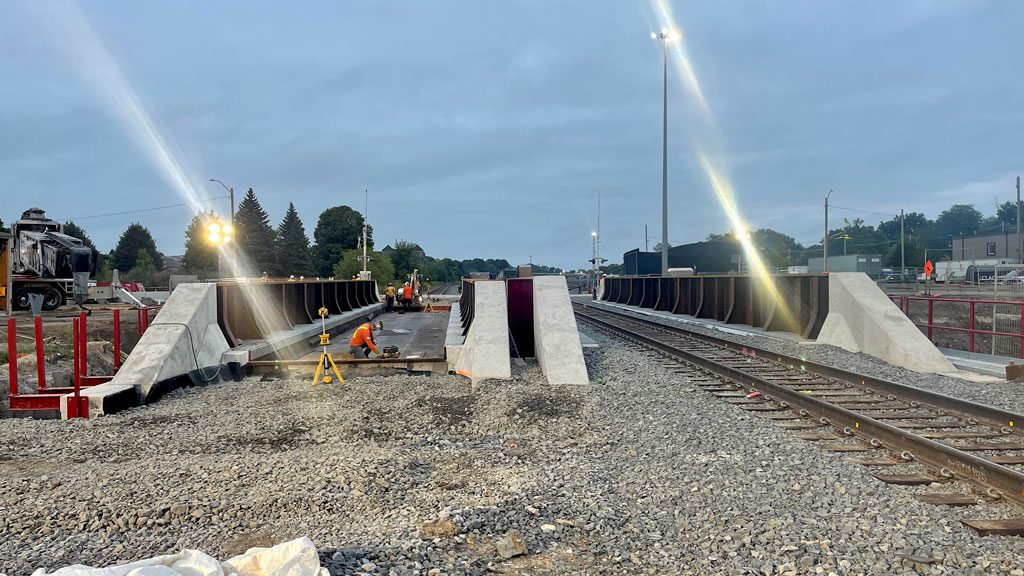An extensive infrastructure project along an east London, Ont. thoroughfare promises to deal with a bottleneck that has drawn complaints from city commuters and politicians for years.
When, in 2018, city councillors unanimously approved the construction of an underpass beneath two Canadian Pacific Kansas City (CPKC) railway lines that crossed Adelaide Street at grade, it was as if the entire city breathed a sigh of relief.
Many days, the lines, located just outside the railway’s yard, blocked traffic for a total of more than 100 minutes. If stalled by a train crossing the road, drivers, cyclists and pedestrians had a 40 per cent chance of a five-minute-plus wait.
Worse still, when long trains travelled the line that stretches east and west across the city, they could block a three-kilometre stretch of north-south streets in or near downtown and potentially increase response time for emergency vehicles.
“The safety concerns associated with pedestrians crossing multiple tracks, and the opportunity to create an uninterrupted north-south corridor for emergency vehicles makes this at-grade crossing location the city’s highest priority for a new grade separation,” stated the project’s 2018 environmental assessment.
Nevertheless, it would take four more years after council’s decision for construction to begin. Now, a year into the $88 million project that began in 2022, city officials say work is on target for completion in 2025.
The city is leading the project, but CPKC “has been active right through the planning and design and now into the construction phase,” says Garfield Dales, the city’s transportation and design division manager. “This project is just adjacent to their rail yard, so it’s really important that there’s a lot of co-ordination with them throughout the whole process.”
The railway continues to be in operation during construction.

Establishing a temporary diversion road has been a necessity. The east-end four-lane artery daily carries 24,000 vehicles. The two-lane detour allows the road to remain open with the exception of periodic and brief closures.
Jennie Dann, London’s director of construction and infrastructure services, says the project’s first stage comprised advance work and took place in 2022. This work included installing and replacing underground infrastructure, building the detour road and beginning the underpass and a pumping station to prevent water from seeping into the underground structure.
Stage two, estimated to take two years, began in the spring. It “includes a lot of really important milestones,” Dann says, identifying the installation of the new rail bridge in late August and early September as one of the most critical elements.
Work also continues on the storm sewer upgrades and the pumping station development that began in the project’s first stage.
During a community information session last year, Scott Schiedel, senior project manager for McLean Taylor Construction Limited, the project’s general contractor, noted the work was “quite complex.” However, “we’re thrilled to be involved and obviously happy that we’re doing the work.”
The goal was “to hit it hard off the hop because there are a lot of interim deadlines that we have to work with with CP.”
The project is progressing well despite the challenges, says Dann. Even this summer’s persistent rainy weather has failed to swamp timelines.
Nor have they encountered supply chain issues.
“I know steel can sometimes be a challenge, but we have a really resilient and resourceful contractor, and we hope to keep things moving,” she says.
Dann acknowledges sourcing labour could be a potential issue, in part because of the large volume of infrastructure construction happening in the city this year, “and so we’ve definitely been working with all of the contractors in the region to make sure they’ve got enough resources to be able to move these projects forward, and so far we have been doing well.”
Once complete, the underpass will improve safety at the intersection, which has been another concern. The new intersection will also sport multi-use paths on either side of the street, improve approaches to a nearby intersection, and add improvements to an adjacent park.
The goal, says Dales, is not only to ease congestion but also to reduce the volume of traffic cutting through nearby neighbourhoods to avoid trains.
The infrastructure project is one of several underway in London this year. Dann says it’s a record year for the city regarding infrastructure construction.
“We’re investing just over $200 million,” in projects that include ongoing work to establish rapid transit in the city’s core and intersection improvements. The projects are over and above routine maintenance of the road network.
“That really ties back to the fact that London has a growing population, and this infrastructure investment is meant to make us more resilient, better able to handle climate change,” she says.



Recent Comments
comments for this post are closed